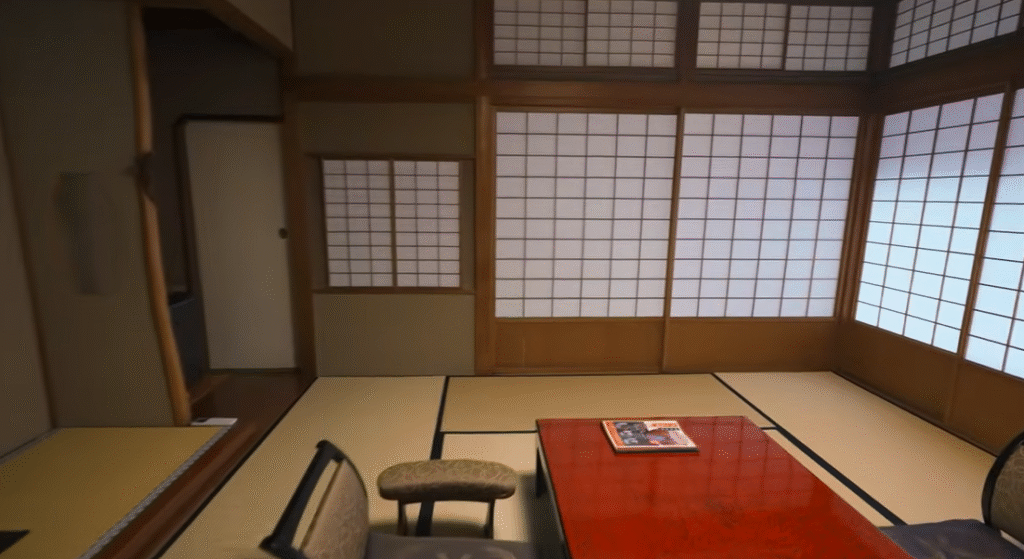A ryokan is more than just a place to sleep; it is a multi-layered cultural performance in which service, tradition, and sensory detail all coexist. A visit to a ryokan is remarkably like entering a play, where the hospitality, food, and architecture all act as characters urging the visitor to find peace. From Lady Gaga to Keanu Reeves, celebrities have embraced this Japanese location because of its discreet yet immersive authenticity, which feels incredibly effective at reestablishing equilibrium after hectic travel schedules.
An especially creative kind of minimalism is provided by the architecture. Every design decision, such as the futons rolled out at night, the sliding paper screens, and the tatami mats beneath the feet, conveys restraint but also adds a level of comfort that is noticeably better than the impersonality of contemporary hotel rooms. Instead of being a void, the absence of grand opulence is a very clear philosophy: luxury is found in quiet, subtlety, and space. The effect is so adaptable that it appeals to both high-end visitors looking for intimacy and tourists on a tight budget.
The kaiseki meal, a multi-course feast of seasonal flavors presented with almost ceremonial precision, transforms dining into theater. The narrative quality of these meals is remarkably similar to haute couture fashion shows, where timing and attention to detail are just as important as the final product. Each dish is served like a brushstroke in a larger painting. Kaiseki would provide Gwyneth Paltrow, who has based her wellness empire on refinement and rituals, with an incredibly resilient model for her own beliefs. This practice is especially helpful for travelers because it promotes awareness, patience, and present-moment appreciation.
Table: Key Information on Ryokan
| Category | Details |
|---|---|
| Name | Ryokan (Traditional Japanese Inn) |
| Origin | 8th Century A.D. (Keiun Period) |
| Famous Early Ryokans | Nishiyama Onsen Keiunkan (705), Hōshi Ryokan (718) |
| Main Features | Tatami-matted rooms, futon bedding, sliding paper doors |
| Hospitality | Omotenashi (exceptional Japanese hospitality) |
| Meals | Kaiseki dinners and traditional breakfasts, often included |
| Baths | Onsen (hot spring baths), communal or private |
| Attire | Yukata robes provided for guests |
| Etiquette | Remove shoes at entrance, bathe before entering onsen, wear slippers |
| Cost Range | 15,000–30,000 yen per person per night (average) |
| Variations | Minshuku (budget version), luxury ryokan, family-run inns |
| Reference | Japan Guide – Ryokan |

The experience is further enhanced by taking an onsen bath. The ritual of cleansing before entering communal hot spring baths, which are frequently made of stone and surrounded by nature, is remarkably explicit in its symbolism of purification. With the rise of wellness tourism in recent years, this technique has proven to be very effective in relieving emotional and physical stress. The method is incredibly successful at fostering presence, and it bears a striking resemblance to the meditative aspects of yoga or mindfulness, which celebrities frequently tout as transformative practices.
Ryokan life revolves around hospitality, which is framed by omotenashi. Compared to the formal service of luxury hotels, staff members anticipate unspoken needs, simplify operations, and free up human talent in ways that feel noticeably faster. The warmth is incredibly dependable because the kindness is ingrained rather than performative. When compared to opulent hotel suites devoid of cultural intimacy, the richness of such service feels surprisingly affordable, even when the costs seem high. The practice shows how custom and service can be remarkably successful in creating enduring emotional memories in addition to being preserved.
Ryokan has adapted with particularly creative tactics in light of tourism trends. For foreign visitors who are not used to sophisticated Japanese dining, many establishments now distinguish between lodging and meals, greatly lowering the barrier. Due to younger travelers’ growing preference for eating at local restaurants, this flexibility has significantly improved since the 2010s. The adaptation is very effective for both hosts and visitors, guaranteeing the ryokan’s continued relevance and enabling nearby communities to profit from tourism.
The ryokan model has been brought to cities by chains like Hoshino Resorts, which combine tatami intimacy with skyscraper efficiency. For instance, their HOSHINOYA property in Tokyo combines contemporary urban conveniences with traditional Japanese architecture to create an experience that is both incredibly durable and much more appealing to audiences around the world. The way heritage fashion houses reinvent their collections season after season is strikingly similar to this adaptation, which echoes global hospitality movements where tradition meets modernity.
In rural Japan, smaller, family-run ryokans continue to flourish, providing incredibly dependable glimpses into daily life. Because they rely on family work, recipes that have been passed down through the generations, and customs that have been quietly passed down, these establishments are incredibly resilient. Similar to how French vineyards or Italian trattorias serve as the foundation for cultural and culinary continuity, they are incredibly successful at maintaining rural economies. In a way that no global hotel chain could match, these small stays serve as a bridge for tourists to comprehend local values.
Ryokan has had to further adapt as a result of social changes in Japan. Many inns are experiencing staff shortages due to an aging workforce and a declining birthrate, which forces them to come up with innovative solutions like encouraging visitors to bring takeout from local restaurants. This model is incredibly transparent in redistributing the benefits of tourism to local communities and surprisingly affordable for tourists. Ryokan owners are reducing operational stress and upholding their core values by working with nearby restaurants.

